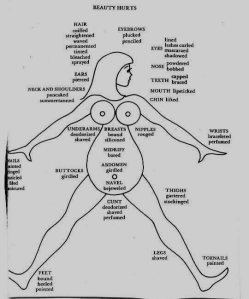Before writing that post, I wanted to cover this new trend.
Dying your armpit hair unnatural colors
Dying your armpit hair unnatural colors is intended to challenge beauty norms of hairless armpits. It's the 'radical' version of having your eyebrows match your blue hair. The goal is to make it socially acceptable for women grow out their armpit hair. The method is that young women are making their grown out armpit hair beautiful and groomed. Hairy armpits are presumed to be dirty, smelly, and un-groomed. By dying their hair an unexpected color, these women and girls demonstrate that they are carefully grooming their armpit hair. Then, by sharing images of themselves casually or focally displaying their dyed armpit hair, they wish to create a new norm.
Now, I should point out that have I participated in the alternative culture. I had blue hair for about a year. I lived in a dorm and campus where dyed and alternative looks are both common and accepted. I am also aware of the general lack of acceptance for some of these body modifications. I know and respect my female friends who have unnatural hair colors, piercings, and tattoos.I'm not mocking the girls who participate in alternative culture or who want to challenge harmful beauty standards for women.
I think it's really commendable to take charge of your appearance as a woman; I'm working on improving my acceptance of my body. I also think it's important for feminists to use a political analysis of our actions. As Daly writes of Jeffreys, "The facts come alive, for the feminist author has no hidden agenda of hiding the horrors." I hope to follow that example of female solidarity by speaking of my lived experience and addressing fellow women activists.
[caption id="attachment_537" align="aligncenter" width="300"]
 Me looking hella punk with blue hair in my blue MIT hoodie[/caption]
Me looking hella punk with blue hair in my blue MIT hoodie[/caption]Analysis: Claims
I'm going to make a claim: this claim is literally the entire premise of my argument. If you need evidence of this claim, please refer to Beauty and Misogyny by Sheila Jeffreys or Chapter 4 of Gyn/ecology by Mary Daly.
My claim: Feminist beauty campaigns should be based on women in their whole, healthy, and strong form. Feminist beauty should be about appreciating women's unaltered natural form and creating a culture of embodying strength.
I'm aware that all bodies are culturally constructed and trained so there's some linguistic lack of nuance in saying 'unaltered' or 'natural'. To clear this confusion, I mean that female bodies are usually coded as vessels of impurity that must be altered in order to be natural or healthy. Women can and should enjoy and appreciate their born bodies as life giving and strong; we don't need to undergo changes that don't improve our health.
Feminist beauty should not be about appealing to men or performing submissive, painful, or feminine practices. Often the cultural construction and alteration of female bodies requires pain as purification or rite of passage. Female bodies should not need different shameful, painful, or active alterations than male bodies.
Throw away comment: getting healthy and strong doesn't have to be painful for men or women. Working out doesn't have to involve pain, vomitting, or shame.
I'm also going to claim that beauty standards are adaptive means of political control.
Evidently, males were able to change their aesthetic standards for female beauty when their politics required this. (Gyn/ecology, Chapter 4, Daly)
Again if you need these claims explained in more detail, please refer to the readings linked as these claims are based in decades of feminist literature, study, and work.
Analysis: Radical Root
I don't think that armpit hair dying is going to get to the root of the desire for control of women's bodies.
Again, the campaign's appeal to acceptance is essentially that women have expended considerable energy modifying their bodies. This expenditure of effort and visible modification of the female body are the core of marking the underarm as clean, healthy, and acceptable. Further, this grooming is in line with other beauty practices for acceptable female hair.
I would liken armpit dying to eyebrow grooming and dying. Women are allowed to have this one bit of hair on their face, but in exchange this hair has very specific parameters. Women are supposed to shave, wax, pluck their peach fuzz, side burns and other facial hair. The only hair that may remain is eyebrow hair. This hair must be groomed, plucked, waxed, dyed, brushed, etc. Make up must be applied to hold the hair in place. Many women who participate in alternative fashion dye their eyebrows to match their head-hair color; others completely shave their eyebrows and draw on matching eyebrows. Eyebrow beauty practice isn't feminist. Eyebrow beauty practice is another means to mark female compliance to unnecessary, arduous, and possibly painful body alterations. Armpit hair dying seems to be a very similar practice to me.
[caption id="attachment_536" align="alignnone" width="249"]
 Beauty Hurts image by Andrea Dworkins[/caption]
Beauty Hurts image by Andrea Dworkins[/caption]link
As this image shows, female beauty hurt is about modifications. Armpit hair dying is an unnecessary modification. Men don't have to dye their armpit hair for their bodies to be seen as clean, healthy, or acceptable. Our campaign as feminists should be to limit the number of modifications women need to perform to their bodies.
Returning to the idea that femininity is an adaptable practice of political control, I think this campaign is easily adapted to uphold femininity, especially racist femininity. Consider how this campaign plays out for our women of color, with long curly coarse hair that resists this hair dying. Consider how it could be painful to expect black women to relax, bleach, and then dye their underarm hair. Are these women included in this campaign? Do women of color have the same access as white women?
Conclusion
SO dying armpit hair is not radical or feminist. The implicit argument of the action is that armpit hair can be just as groomed, treated, and cordoned as any other female’s body hair for feminine performance. The appeal to acceptance is that by adding another complex (and likely painful) grooming routine we can replace shaving.
Adding more grooming and feminine alterations to women’s daily routines is not a feminist enterprise of loving the female body as it is, clean healthy and whole.
No comments :
Post a Comment